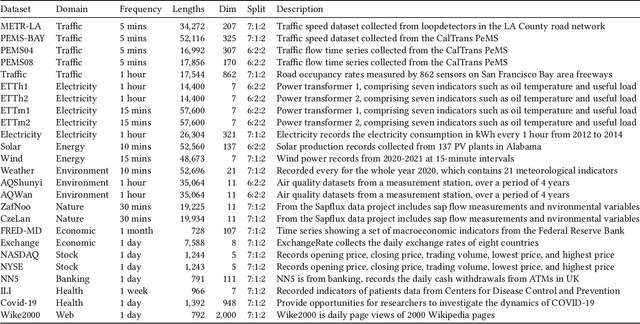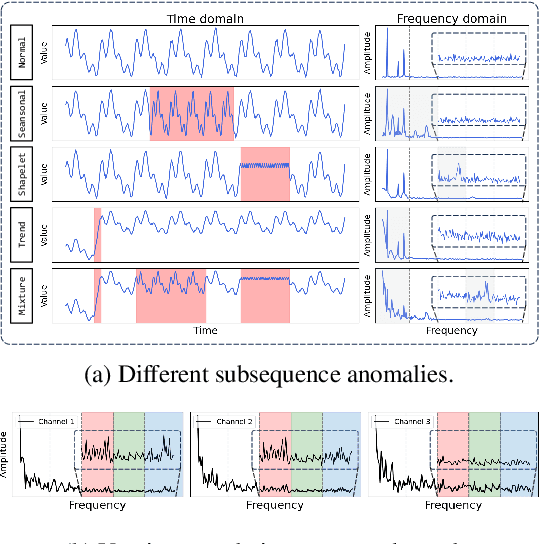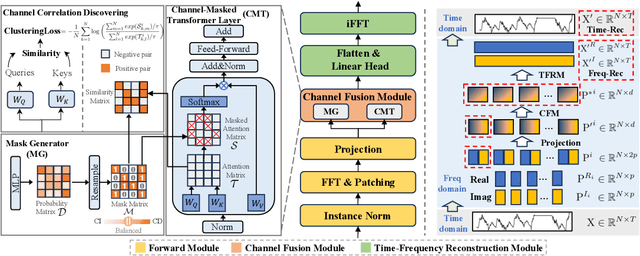Xingjian Wu
Enhancing Time Series Forecasting through Selective Representation Spaces: A Patch Perspective
Oct 16, 2025Abstract:Time Series Forecasting has made significant progress with the help of Patching technique, which partitions time series into multiple patches to effectively retain contextual semantic information into a representation space beneficial for modeling long-term dependencies. However, conventional patching partitions a time series into adjacent patches, which causes a fixed representation space, thus resulting in insufficiently expressful representations. In this paper, we pioneer the exploration of constructing a selective representation space to flexibly include the most informative patches for forecasting. Specifically, we propose the Selective Representation Space (SRS) module, which utilizes the learnable Selective Patching and Dynamic Reassembly techniques to adaptively select and shuffle the patches from the contextual time series, aiming at fully exploiting the information of contextual time series to enhance the forecasting performance of patch-based models. To demonstrate the effectiveness of SRS module, we propose a simple yet effective SRSNet consisting of SRS and an MLP head, which achieves state-of-the-art performance on real-world datasets from multiple domains. Furthermore, as a novel plugin-and-play module, SRS can also enhance the performance of existing patch-based models. The resources are available at https://github.com/decisionintelligence/SRSNet.
Aurora: Towards Universal Generative Multimodal Time Series Forecasting
Sep 26, 2025Abstract:Cross-domain generalization is very important in Time Series Forecasting because similar historical information may lead to distinct future trends due to the domain-specific characteristics. Recent works focus on building unimodal time series foundation models and end-to-end multimodal supervised models. Since domain-specific knowledge is often contained in modalities like texts, the former lacks the explicit utilization of them, thus hindering the performance. The latter is tailored for end-to-end scenarios and does not support zero-shot inference for cross-domain scenarios. In this work, we introduce Aurora, a Multimodal Time Series Foundation Model, which supports multimodal inputs and zero-shot inference. Pretrained on Corss-domain Multimodal Time Series Corpus, Aurora can adaptively extract and focus on key domain knowledge contained in corrsponding text or image modalities, thus possessing strong Cross-domain generalization capability. Through tokenization, encoding, and distillation, Aurora can extract multimodal domain knowledge as guidance and then utilizes a Modality-Guided Multi-head Self-Attention to inject them into the modeling of temporal representations. In the decoding phase, the multimodal representations are used to generate the conditions and prototypes of future tokens, contributing to a novel Prototype-Guided Flow Matching for generative probabilistic forecasting. Comprehensive experiments on well-recognized benchmarks, including TimeMMD, TSFM-Bench and ProbTS, demonstrate the consistent state-of-the-art performance of Aurora on both unimodal and multimodal scenarios.
Unlocking the Power of Mixture-of-Experts for Task-Aware Time Series Analytics
Sep 26, 2025Abstract:Time Series Analysis is widely used in various real-world applications such as weather forecasting, financial fraud detection, imputation for missing data in IoT systems, and classification for action recognization. Mixture-of-Experts (MoE), as a powerful architecture, though demonstrating effectiveness in NLP, still falls short in adapting to versatile tasks in time series analytics due to its task-agnostic router and the lack of capability in modeling channel correlations. In this study, we propose a novel, general MoE-based time series framework called PatchMoE to support the intricate ``knowledge'' utilization for distinct tasks, thus task-aware. Based on the observation that hierarchical representations often vary across tasks, e.g., forecasting vs. classification, we propose a Recurrent Noisy Gating to utilize the hierarchical information in routing, thus obtaining task-sepcific capability. And the routing strategy is operated on time series tokens in both temporal and channel dimensions, and encouraged by a meticulously designed Temporal \& Channel Load Balancing Loss to model the intricate temporal and channel correlations. Comprehensive experiments on five downstream tasks demonstrate the state-of-the-art performance of PatchMoE.
DAG: A Dual Causal Network for Time Series Forecasting with Exogenous Variables
Sep 18, 2025Abstract:Time series forecasting is crucial in various fields such as economics, traffic, and AIOps. However, in real-world applications, focusing solely on the endogenous variables (i.e., target variables), is often insufficient to ensure accurate predictions. Considering exogenous variables (i.e., covariates) provides additional predictive information, thereby improving forecasting accuracy. However, existing methods for time series forecasting with exogenous variables (TSF-X) have the following shortcomings: 1) they do not leverage future exogenous variables, 2) they fail to account for the causal relationships between endogenous and exogenous variables. As a result, their performance is suboptimal. In this study, to better leverage exogenous variables, especially future exogenous variable, we propose a general framework DAG, which utilizes dual causal network along both the temporal and channel dimensions for time series forecasting with exogenous variables. Specifically, we first introduce the Temporal Causal Module, which includes a causal discovery module to capture how historical exogenous variables affect future exogenous variables. Following this, we construct a causal injection module that incorporates the discovered causal relationships into the process of forecasting future endogenous variables based on historical endogenous variables. Next, we propose the Channel Causal Module, which follows a similar design principle. It features a causal discovery module models how historical exogenous variables influence historical endogenous variables, and a causal injection module incorporates the discovered relationships to enhance the prediction of future endogenous variables based on future exogenous variables.
$K^2$VAE: A Koopman-Kalman Enhanced Variational AutoEncoder for Probabilistic Time Series Forecasting
May 29, 2025



Abstract:Probabilistic Time Series Forecasting (PTSF) plays a crucial role in decision-making across various fields, including economics, energy, and transportation. Most existing methods excell at short-term forecasting, while overlooking the hurdles of Long-term Probabilistic Time Series Forecasting (LPTSF). As the forecast horizon extends, the inherent nonlinear dynamics have a significant adverse effect on prediction accuracy, and make generative models inefficient by increasing the cost of each iteration. To overcome these limitations, we introduce $K^2$VAE, an efficient VAE-based generative model that leverages a KoopmanNet to transform nonlinear time series into a linear dynamical system, and devises a KalmanNet to refine predictions and model uncertainty in such linear system, which reduces error accumulation in long-term forecasting. Extensive experiments demonstrate that $K^2$VAE outperforms state-of-the-art methods in both short- and long-term PTSF, providing a more efficient and accurate solution.
Rethinking Irregular Time Series Forecasting: A Simple yet Effective Baseline
May 16, 2025Abstract:The forecasting of irregular multivariate time series (IMTS) is crucial in key areas such as healthcare, biomechanics, climate science, and astronomy. However, achieving accurate and practical predictions is challenging due to two main factors. First, the inherent irregularity and data missingness in irregular time series make modeling difficult. Second, most existing methods are typically complex and resource-intensive. In this study, we propose a general framework called APN to address these challenges. Specifically, we design a novel Time-Aware Patch Aggregation (TAPA) module that achieves adaptive patching. By learning dynamically adjustable patch boundaries and a time-aware weighted averaging strategy, TAPA transforms the original irregular sequences into high-quality, regularized representations in a channel-independent manner. Additionally, we use a simple query module to effectively integrate historical information while maintaining the model's efficiency. Finally, predictions are made by a shallow MLP. Experimental results on multiple real-world datasets show that APN outperforms existing state-of-the-art methods in both efficiency and accuracy.
EasyTime: Time Series Forecasting Made Easy
Dec 23, 2024



Abstract:Time series forecasting has important applications across diverse domains. EasyTime, the system we demonstrate, facilitates easy use of time-series forecasting methods by researchers and practitioners alike. First, EasyTime enables one-click evaluation, enabling researchers to evaluate new forecasting methods using the suite of diverse time series datasets collected in the preexisting time series forecasting benchmark (TFB). This is achieved by leveraging TFB's flexible and consistent evaluation pipeline. Second, when practitioners must perform forecasting on a new dataset, a nontrivial first step is often to find an appropriate forecasting method. EasyTime provides an Automated Ensemble module that combines the promising forecasting methods to yield superior forecasting accuracy compared to individual methods. Third, EasyTime offers a natural language Q&A module leveraging large language models. Given a question like "Which method is best for long term forecasting on time series with strong seasonality?", EasyTime converts the question into SQL queries on the database of results obtained by TFB and then returns an answer in natural language and charts. By demonstrating EasyTime, we intend to show how it is possible to simplify the use of time series forecasting and to offer better support for the development of new generations of time series forecasting methods.
DUET: Dual Clustering Enhanced Multivariate Time Series Forecasting
Dec 14, 2024



Abstract:Multivariate time series forecasting is crucial for various applications, such as financial investment, energy management, weather forecasting, and traffic optimization. However, accurate forecasting is challenging due to two main factors. First, real-world time series often show heterogeneous temporal patterns caused by distribution shifts over time. Second, correlations among channels are complex and intertwined, making it hard to model the interactions among channels precisely and flexibly. In this study, we address these challenges by proposing a general framework called \textbf{DUET}, which introduces \underline{DU}al clustering on the temporal and channel dimensions to \underline{E}nhance multivariate \underline{T}ime series forecasting. First, we design a Temporal Clustering Module (TCM) that clusters time series into fine-grained distributions to handle heterogeneous temporal patterns. For different distribution clusters, we design various pattern extractors to capture their intrinsic temporal patterns, thus modeling the heterogeneity. Second, we introduce a novel Channel-Soft-Clustering strategy and design a Channel Clustering Module (CCM), which captures the relationships among channels in the frequency domain through metric learning and applies sparsification to mitigate the adverse effects of noisy channels. Finally, DUET combines TCM and CCM to incorporate both the temporal and channel dimensions. Extensive experiments on 25 real-world datasets from 10 application domains, demonstrate the state-of-the-art performance of DUET.
CATCH: Channel-Aware multivariate Time Series Anomaly Detection via Frequency Patching
Oct 16, 2024



Abstract:Anomaly detection in multivariate time series is challenging as heterogeneous subsequence anomalies may occur. Reconstruction-based methods, which focus on learning nomral patterns in the frequency domain to detect diverse abnormal subsequences, achieve promising resutls, while still falling short on capturing fine-grained frequency characteristics and channel correlations. To contend with the limitations, we introduce CATCH, a framework based on frequency patching. We propose to patchify the frequency domain into frequency bands, which enhances its ability to capture fine-grained frequency characteristics. To perceive appropriate channel correlations, we propose a Channel Fusion Module (CFM), which features a patch-wise mask generator and a masked-attention mechanism. Driven by a bi-level multi-objective optimization algorithm, the CFM is encouraged to iteratively discover appropriate patch-wise channel correlations, and to cluster relevant channels while isolating adverse effects from irrelevant channels. Extensive experiments on 9 real-world datasets and 12 synthetic datasets demonstrate that CATCH achieves state-of-the-art performance.
TFB: Towards Comprehensive and Fair Benchmarking of Time Series Forecasting Methods
Apr 08, 2024



Abstract:Time series are generated in diverse domains such as economic, traffic, health, and energy, where forecasting of future values has numerous important applications. Not surprisingly, many forecasting methods are being proposed. To ensure progress, it is essential to be able to study and compare such methods empirically in a comprehensive and reliable manner. To achieve this, we propose TFB, an automated benchmark for Time Series Forecasting (TSF) methods. TFB advances the state-of-the-art by addressing shortcomings related to datasets, comparison methods, and evaluation pipelines: 1) insufficient coverage of data domains, 2) stereotype bias against traditional methods, and 3) inconsistent and inflexible pipelines. To achieve better domain coverage, we include datasets from 10 different domains: traffic, electricity, energy, the environment, nature, economic, stock markets, banking, health, and the web. We also provide a time series characterization to ensure that the selected datasets are comprehensive. To remove biases against some methods, we include a diverse range of methods, including statistical learning, machine learning, and deep learning methods, and we also support a variety of evaluation strategies and metrics to ensure a more comprehensive evaluations of different methods. To support the integration of different methods into the benchmark and enable fair comparisons, TFB features a flexible and scalable pipeline that eliminates biases. Next, we employ TFB to perform a thorough evaluation of 21 Univariate Time Series Forecasting (UTSF) methods on 8,068 univariate time series and 14 Multivariate Time Series Forecasting (MTSF) methods on 25 datasets. The benchmark code and data are available at https://github.com/decisionintelligence/TFB.
 Add to Chrome
Add to Chrome Add to Firefox
Add to Firefox Add to Edge
Add to Edge